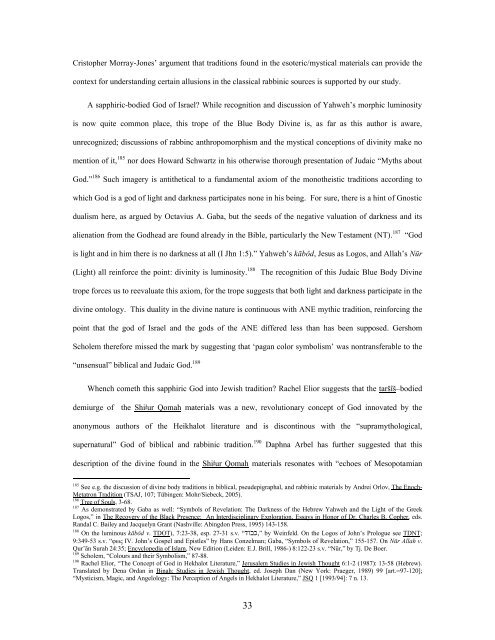Sapphiric God: - Dr. Wesley Muhammad
Sapphiric God: - Dr. Wesley Muhammad
Sapphiric God: - Dr. Wesley Muhammad
Create successful ePaper yourself
Turn your PDF publications into a flip-book with our unique Google optimized e-Paper software.
Cristopher Morray-Jones’ argument that traditions found in the esoteric/mystical materials can provide the<br />
context for understanding certain allusions in the classical rabbinic sources is supported by our study.<br />
A sapphiric-bodied <strong>God</strong> of Israel? While recognition and discussion of Yahweh’s morphic luminosity<br />
is now quite common place, this trope of the Blue Body Divine is, as far as this author is aware,<br />
unrecognized; discussions of rabbinc anthropomorphism and the mystical conceptions of divinity make no<br />
mention of it, 185 nor does Howard Schwartz in his otherwise thorough presentation of Judaic “Myths about<br />
<strong>God</strong>.” 186 Such imagery is antithetical to a fundamental axiom of the monotheistic traditions according to<br />
which <strong>God</strong> is a god of light and darkness participates none in his being. For sure, there is a hint of Gnostic<br />
dualism here, as argued by Octavius A. Gaba, but the seeds of the negative valuation of darkness and its<br />
alienation from the <strong>God</strong>head are found already in the Bible, particularly the New Testament (NT). 187 “<strong>God</strong><br />
is light and in him there is no darkness at all (I Jhn 1:5).” Yahweh’s kābôd, Jesus as Logos, and Allah’s Nūr<br />
(Light) all reinforce the point: divinity is luminosity. 188 The recognition of this Judaic Blue Body Divine<br />
trope forces us to reevaluate this axiom, for the trope suggests that both light and darkness participate in the<br />
divine ontology. This duality in the divine nature is continuous with ANE mythic tradition, reinforcing the<br />
point that the god of Israel and the gods of the ANE differed less than has been supposed. Gershom<br />
Scholem therefore missed the mark by suggesting that ‘pagan color symbolism’ was nontransferable to the<br />
“unsensual” biblical and Judaic <strong>God</strong>. 189<br />
Whench cometh this sapphiric <strong>God</strong> into Jewish tradition? Rachel Elior suggests that the taršîš–bodied<br />
demiurge of the Shi#ur Qomah materials was a new, revolutionary concept of <strong>God</strong> innovated by the<br />
anonymous authors of the Heikhalot literature and is discontinous with the “supramythological,<br />
supernatural” <strong>God</strong> of biblical and rabbinic tradition. 190 Daphna Arbel has further suggested that this<br />
description of the divine found in the Shi#ur Qomah materials resonates with “echoes of Mesopotamian<br />
185 See e.g. the discussion of divine body traditions in biblical, pseudepigraphal, and rabbinic materials by Andrei Orlov, The Enoch-<br />
Metatron Tradition (TSAJ, 107; Tübingen: Mohr/Siebeck, 2005).<br />
186 Tree of Souls, 3-68.<br />
187 As demonstrated by Gaba as well: “Symbols of Revelation: The Darkness of the Hebrew Yahweh and the Light of the Greek<br />
Logos,” in The Recovery of the Black Presence: An Interdisciplinary Exploration. Essays in Honor of <strong>Dr</strong>. Charles B. Copher, eds.<br />
Randal C. Bailey and Jacquelyn Grant (Nashville: Abingdon Press, 1995) 143-158.<br />
188 On the luminous kābôd v. TDOT), 7:23-38, esp. 27-31 s.v. “דובכ,” by Weinfeld. On the Logos of John’s Prologue see TDNT;<br />
9:349-53 s.v. “φως IV. John’s Gospel and Epistles” by Hans Conzelman; Gaba, “Symbols of Revelation,” 155-157. On Nūr Allah v.<br />
Qur’ān Surah 24:35; Encyclopedia of Islam, New Edition (Leiden: E.J. Brill, 1986-) 8:122-23 s.v. “Nūr,” by Tj. De Boer.<br />
189 Scholem, “Colours and their Symbolism,” 87-88.<br />
190 Rachel Elior, “The Concept of <strong>God</strong> in Hekhalot Literature,” Jerusalem Studies in Jewish Thought 6:1-2 (1987): 13-58 (Hebrew).<br />
Translated by Dena Ordan in Binah: Studies in Jewish Thought, ed. Joseph Dan (New York: Praeger, 1989) 99 [art.=97-120];<br />
“Mysticism, Magic, and Angelology: The Perception of Angels in Hekhalot Literature,” JSQ 1 [1993/94]: 7 n. 13.<br />
33
















